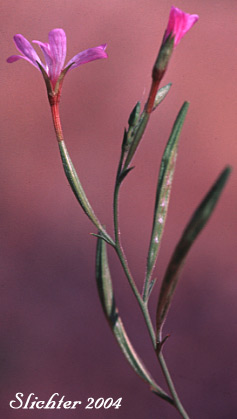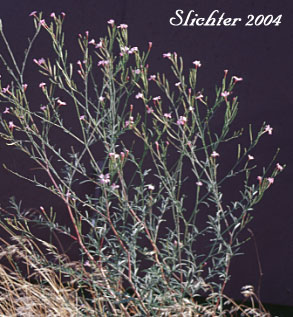 The
photo at right shows a close-up side view of the flower of tall annual willowherb
as seen at Viento State Park, OR, Columbia River Gorge.............August 25,
2002. This is formerly E. paniculatum var. jucundum.
The
photo at right shows a close-up side view of the flower of tall annual willowherb
as seen at Viento State Park, OR, Columbia River Gorge.............August 25,
2002. This is formerly E. paniculatum var. jucundum.
Tall annual willowherb is also known as panicled willowherb. It is a taprooted annual wildflower with simple to more often branched stems from 20-100 cm high. The herbage is often glabrous below but glandular hairy above. The leaves are short-petiolate or sessile, linear to narrowly lanceolate or elliptic in shape and alternate on the stems. The stem leaves vary from 2-7 cm long and are 2-8 mm wide with entire to irregulary toothed margins. The blades may also be folded along the midrib.
The inflorescence at first appears as a panicle, but is really a terminal raceme at the end of each branch. The racemes are lax and few-flowered. The flowers are subtended by small, leaf-like bracts. The pedicels are 5-20 mm long while the floral tube is 1-8 mm long. The 4 sepals are each 1-3 mm long. Each of the 4 petals is white or mostly pink, 2-6 mm long and cleft 1/3-1/2 the length of the petal (See photo above.).Stigma is divided into 4 very short, erect lobes. The fruit is a capsule from 1.5-3 cm long. The outer surface of the capsule may be glabrous or slightly glandular hairy.
Variety jucundum: The petals generally rose-colored and are 7-13 mm long. The hypan is 5-12 mm. Found from coastal Washington south to California and east to Idaho.
Variety paniculatum: The petals are light pink and generally less than 7 mm long. The hypan is less than 5 mm. Found from the west coast from British Columbia south to southern California and east to the Dakotas and New Mexico.
Tall annual willowherb is found in dry to moderately moist places in open areas or in thinly wooded forests from the lowlands to moderate elevations.
Tall annual willowherb is found from southern Canada south along the west coast and intermountain basins to Mexico and east onto the great Plains in North and South Dakota.
